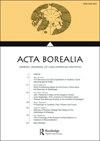Historic settlements and pastoralism in the Arctic and Tibetan Plateau: towards a comparison
IF 0.6
4区 社会学
0 HUMANITIES, MULTIDISCIPLINARY
引用次数: 0
Abstract
ABSTRACT Historic settlement processes of, respectively, the Northern Sámi and Western Tibetan pastoralists have so far not been subjected to any comparative social science analyses. This study contributes to such a conceptual platform, drawing on the constructs dwelling, settlement, herding unit, pastoral landscape and the labour–animal–pasture triangle. Ethnographic and archival evidence of transitions from sedentary/semi-sedentary to full-fledged pastoralist societies and transitions from a pastoral adaptation to sedentary and semi-sedentary life are analysed and debated in light of the influential theoretical proposition of a categorical difference between a nomad’s and a farmer’s dwelling. At the core of this, comparative inquiry is two highly dynamic pastoral herding societies. It is argued that a comparative approach to the study of settlements requires a theoretical and analytical reframing – informed by a more adequate comprehension of the dwelling–settlement nexus. This preliminary scrutiny of dwelling designs and settlement practices of Sámi and Tibetan pastoralists indicates that nomads in both regions internalized and activated different spatial models and inventively mediated between different spatial models according to seasonal or irreversible shifts of leaving the nomadic adaptation altogether. Further rigorous empirical inquiry into accommodation, innovation and possible failures to mediate gaps in the making/remaking of dwellings and settlements are called for.北极和青藏高原的历史定居点与畜牧业:比较
西藏北部Sámi和西部牧民的历史定居过程迄今为止还没有任何比较的社会科学分析。本研究通过构建住宅、聚落、放牧单元、田园景观和劳动-动物-牧场三角关系,为这样一个概念平台做出了贡献。从定居/半定居到成熟的游牧社会过渡的民族志和档案证据,以及从游牧适应到定居和半定居生活的过渡,根据有影响力的理论命题,即游牧和农民居住之间的绝对差异,进行了分析和辩论。比较研究的核心是两个高度动态的牧区社会。有人认为,用比较的方法研究住区需要在理论上和分析上进行重新规划- -对住区关系有更充分的了解。对Sámi和西藏牧民居住设计和定居实践的初步考察表明,这两个地区的牧民内化和激活了不同的空间模式,并根据完全离开游牧适应的季节性或不可逆转的转变,创造性地在不同的空间模式之间进行调解。需要对住房、创新和可能未能调解住房和住区建造/重建中的差距进行进一步严格的实证调查。
本文章由计算机程序翻译,如有差异,请以英文原文为准。
求助全文
约1分钟内获得全文
求助全文

 求助内容:
求助内容: 应助结果提醒方式:
应助结果提醒方式:


